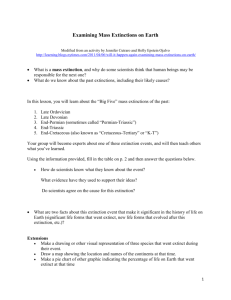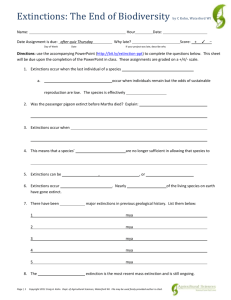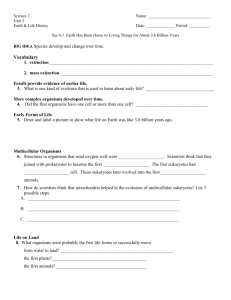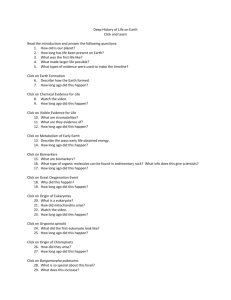Mass Extinction Fact Sheet
advertisement
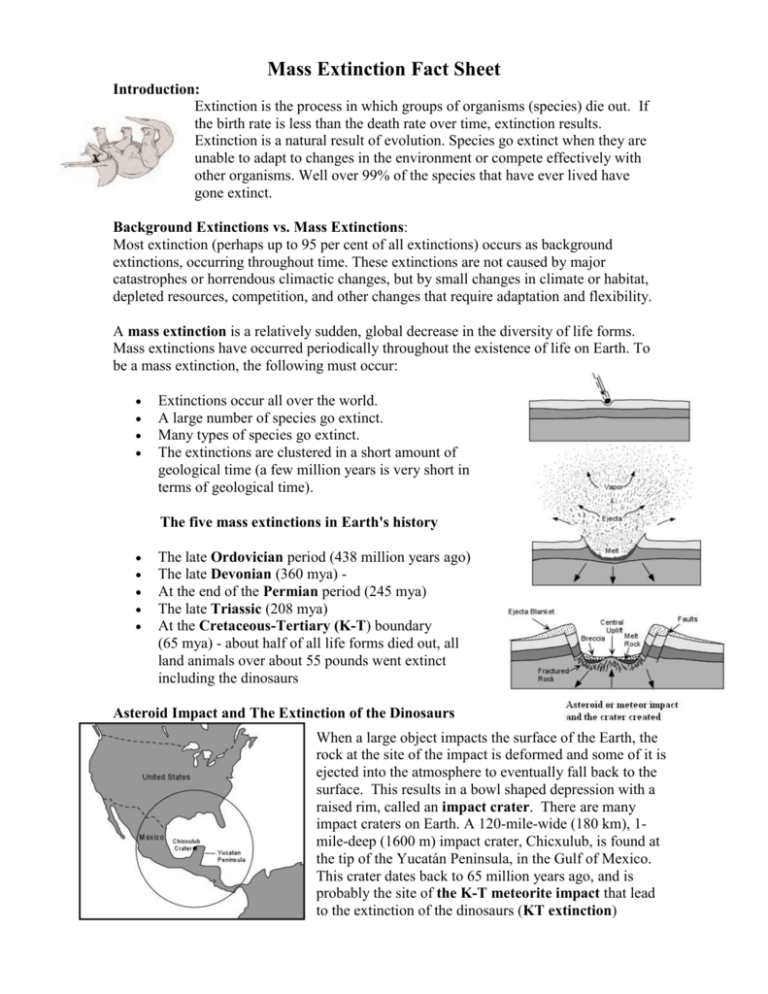
Mass Extinction Fact Sheet Introduction: Extinction is the process in which groups of organisms (species) die out. If the birth rate is less than the death rate over time, extinction results. Extinction is a natural result of evolution. Species go extinct when they are unable to adapt to changes in the environment or compete effectively with other organisms. Well over 99% of the species that have ever lived have gone extinct. Background Extinctions vs. Mass Extinctions: Most extinction (perhaps up to 95 per cent of all extinctions) occurs as background extinctions, occurring throughout time. These extinctions are not caused by major catastrophes or horrendous climactic changes, but by small changes in climate or habitat, depleted resources, competition, and other changes that require adaptation and flexibility. A mass extinction is a relatively sudden, global decrease in the diversity of life forms. Mass extinctions have occurred periodically throughout the existence of life on Earth. To be a mass extinction, the following must occur: Extinctions occur all over the world. A large number of species go extinct. Many types of species go extinct. The extinctions are clustered in a short amount of geological time (a few million years is very short in terms of geological time). The five mass extinctions in Earth's history The late Ordovician period (438 million years ago) The late Devonian (360 mya) At the end of the Permian period (245 mya) The late Triassic (208 mya) At the Cretaceous-Tertiary (K-T) boundary (65 mya) - about half of all life forms died out, all land animals over about 55 pounds went extinct including the dinosaurs Asteroid Impact and The Extinction of the Dinosaurs When a large object impacts the surface of the Earth, the rock at the site of the impact is deformed and some of it is ejected into the atmosphere to eventually fall back to the surface. This results in a bowl shaped depression with a raised rim, called an impact crater. There are many impact craters on Earth. A 120-mile-wide (180 km), 1mile-deep (1600 m) impact crater, Chicxulub, is found at the tip of the Yucatán Peninsula, in the Gulf of Mexico. This crater dates back to 65 million years ago, and is probably the site of the K-T meteorite impact that lead to the extinction of the dinosaurs (KT extinction) Mass Extinctions and Meteor Impacts Questions about Mass Extinctions: 1. What is extinction? 2. What makes a mass extinction different from a background extinction? 3. How many mass extinctions have occurred during the Earth’s history? 4. What mass extinction was responsible for the extinction of the dinosaurs? 5. What event is believed to have caused the extinction of the dinosaurs? 6. Where is the crater located that caused this extinction? Interpreting Mass Extinction Graphs: 1. How many mass extinctions are shown on this graph? 2. During what time period did the largest mass extinction occur? 3. What could have been the cause of these mass extinctions? 1. What is the highest extinction percentage shown on the graph above? 2. During what geologic period did this occur? 3. The extinction of what creatures is commonly associated with this mass extinction? 1. Which of these graphs shows the impact that a catostrophic event such as an asteroid impact would have on a population? 2. Which of these graphs shows a stable population? 3. Which of these graphs shows a population growing and stabilizing? 4. Which of these graphs shows a population that is fluctuating?



